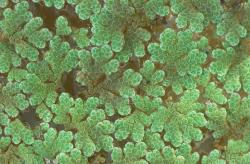- = Azollaceae Wettst., Handb. Syst. Bot. 2, 77 (1903)
Aquatic ferns, free-floating. Stems slender, branching, glabrous or hairy; roots either long and pendent, or absent. Leaves either monomorphic and bilobed, with the upper lobe aerial and green and the lower colourless and floating, or dimorphic and arranged in whorls of 3, with two floating and one submerged; not articulated, herbaceous, papillate or with very specialised hairs, non-circinate when young. Veins anastomosing, or absent. Sporocarps globose or conical, sessile or stalked, glabrous or hairy, either attached to the lower lobes of bilobed leaves, or to the submerged leaves, splitting open irregularly, each sporocarp bearing either mega- or microsporangiate sori. Annulus absent. Heterosporous, spores trilete, lacking chlorophyll; one megaspore in each megasporangium and 32–64 microspores in each microsporangium. Megaspores spheroidal, plain to tuberculate; microspores spheroidal, and plain to rugulate.
A family of two genera and about 17 species. The Salviniaceae comprises floating aquatic ferns with highly modified leaves adapted for flotation, mega- and micro-sporangia borne in hardened sporocarps that give rise to mega- and micro-spores, and spores which germinate into greatly reduced gametophytes still attached to the parent spore.
Pryer (1999) and Pryer et al. (2004) showed that the heterosporous ferns, Salviniales, are one of three major lineages of "core leptosporangiate" ferns, along with tree ferns and polypod ferns. Nagalingum et al. (2008) subsequently confirmed that Salviniales is divided into two strongly supported families, the Marsileaceae and Salviniaceae, and that within Salviniaceae there is strong support for recognition of two genera, Azolla and Salvinia. Schneider & Pryer (2002) also demonstrated that the spores of Marsileaceae are markedly different to those of Salviniaceae and all homosporous ferns. The morphology of the reproductive structures in heterosporous water ferns has been critically examined by Nagalingum et al. (2006).
Some authors (Schneller 1990; Chinnock 1998; Jones 1998) recognise two separate families, Azollaceae and Salviniaceae, on the basis of the significant differences in the morphology of the two groups, but we follow Smith et al. (2006) and Christenhusz et al. (2011) in recognising just one family.
It is represented in New Zealand by one indigenous genus (Azolla) and one fully naturalised genus (Salvinia).
Widespread in tropical and temperate regions. One native and one naturalised genus with three species in New Zealand; none endemic.
| Category | Number |
|---|---|
| Indigenous (Non-endemic) | 1 |
| Exotic: Fully Naturalised | 2 |
| Total | 3 |




